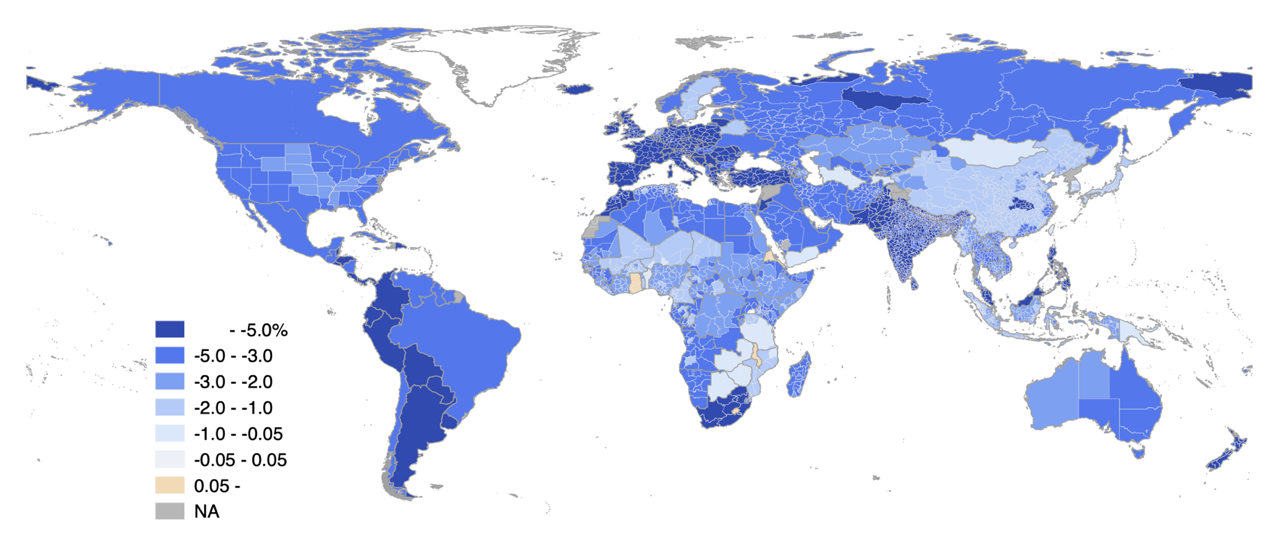Impact of the 2019 Novel Coronavirus on Global Economy: Analysis Using Mobility Data from Mobile Phones
IDE Policy Brief
No.11
Satoru KUMAGAI, Toshitaka GOKAN, Kenmei TSUBOTA, Ikumo ISONO, Kazunobu HAYAKAWA, Souknilanh KEOLA
PDF (478KB)
- IDE’s Geographical Simulation Model was used to evaluate the impact of the novel coronavirus on the global economy utilizing the information from mobile phone location data to model changes in the movement of people. If the situation at the end of March (the end of February in China) continues for another month, the global GDP will decrease by 4.2% over the year.
- By country/region, the EU will experience the largest impact (-6.2%), followed by the USA (-3.7%), ASEAN (-3.6%), China (-2.9%), and Japan (-1.6%). The impact on South Korea (-0.8%) and Taiwan (-0.3%) will be comparatively small, reflecting the successful infection management.
Introduction
The novel coronavirus (COVID-19) began in China at the end of December 2019 and has since globally infected 2.8 million people with more than 190,000 deaths, and continues to spread (WHO, April 26). Economic activity, movement of people, and logistics have been restricted in countries around the world, and the global economy will be seriously damaged.
Because the infection status of COVID-19 is continuously changing, there are few detailed estimations of the magnitude of its impact. Furthermore, the world economy is becoming more interdependent due to supply chains and the movement of people, making the transmission mechanism of the adverse effect hard to predict. This paper explicates this issue by utilizing the Institute of Developing Economies’ Geographic Simulation Model (IDE-GSM)1 with newly available data on the mobility of people to calculate the impact of the virus on each country and region of the world.
The IDE-GSM allows a variety of simulations to be performed by changing parameters and data on transportation networks. In this paper, we simulate the impact of reduced labor input, restricted land transportation in China and the EU, less frequent aircraft flights and raising overheads, and restricting the free movement of people.
Scenario
Our simulation of the impact of COVID-19 on the global economy incorporates the following factors.
Decreased labor input: Labor input to the industrial sectors other than the service sector is reduced according to the reduced mobility of people to ‘workplace,’ reported in the COVID-19 Community Mobility Reports2(CMR, hereafter) dated March 31. Labor input to the service sector is reduced according to the average decline of the movement to ‘retail and recreation’ and ‘grocery and pharmacy,’ as reported in CMR3. In the USA, the decrease in labor input is set for each state, as CMR data is provided at the state level. As there is no CMR data available for China, we compiled the assumptions mainly based on the dependency of inter-provincial migrant labor4. The decrease in labor input in each province and city is assumed between 10% and 50%. For Hubei Province, most severely affected by COVID-19, the labor input was reduced to 70% in the service sector, and to 95% in other industries.
Land traffic restrictions: A 72-hour waiting time was assumed at the provincial borders for roads and railways transport in and out of Hubei province. In Europe, this was assumed to be six hours for routes between Schengen member countries, reflecting that border quarantine is causing delays between countries; otherwise, free movement of people is ensured.
Less international flights: the frequency of flights in the model is reduced to reflect the less frequent international/domestic flights across the world. Furthermore, airfare/km was doubled to reflect the skyrocketing costs of air freight caused by limited capacity. Additionally, non-tariff barriers in services between countries were assumed to have doubled to reflect the impact of mutually imposed immigration restrictions5.
As IDE-GSM is an annual model, we first applied the above assumptions for 2020-2021, then calculated the differences in GDP against the baseline scenario with no impact from COVID-19. After that, by dividing the economic impact for one year by 12, the economic impact of assuming that the situation at the end of March continues for one month with COVID-19 is obtained6.
It is expected that labor input and logistics will swiftly return to normal once the COVID-19 epidemic subsides (although it is not easy) and that some of the decreases in GDP will be offset by delayed demand. Furthermore, given that each country has implemented large-scale economic measures in response to the pandemic, our estimates should be taken as the upper limit of what is expected.
On the other hand, if the pandemic itself and the lockdown measures intended to slow the spread of COVID-19 are in place for longer than a month, the economic impact will be multiple. Note that the analysis in this report assumes the situation at the end of March (the end of February in China) continues only for a month.
Note also that IDE-GSM estimates do not take into account the effects of (1) disturbance in financial markets, (2) exchange rate fluctuations, (3) instability in commodity prices, and (4) business stagnation due to rising uncertainty, all of which may occur as a result of COVID-19.
Estimated Results
Tables 1.1 and 1.2 indicate the impact of COVID-19 by country/region. Global GDP is expected to contract by 4.2%, with the most significant impact registered by the service industry. There is a substantial impact on the EU (-6.2%), while the effect on the USA (-3.7%) exceeds that of China (-2.9%).
Table 1.1: The impact of COVID-19 by scenario (relative to baseline GDP, converted into monthly impact).

Table 1.2: Impact of COVID-19 by country/region (relative to baseline GDP(2020))

Of the ASEAN countries, the Philippines and Malaysia are most impacted, while the effect on the four CLMV countries is comparatively small. For Indonesia, the impact is more substantial in urban areas like Jakarta, where the service and manufacturing industries are concentrated, while the impacts are relatively smaller in rural areas with a large share of agriculture and mining.
Although the overall number of infections in South American countries is low, the CMR migration data shows a considerable reduction in migration, which has significantly impacted the simulation. It is also possible that the small number of infections is due to inadequate testing for COVID-19.
In Africa, the most significant impact is observed in South Africa and Morocco, while other countries experience comparatively smaller impacts. CMR data for many African countries indicate a small decrease in the movement of people, and the infection seems to have not spread widely by the end of March. However, many countries in the region have a poor state of public health, and attention must be paid to further spread of the infection.
Figure 1: Impact of COVID-19 by country/region (relative to baseline GDP)

Conclusion
It is challenging to make estimations of the global economy based on the latest situation given that the infection of COVID-19 in each country and the countermeasures deployed, such as the declaration of emergency and movement control order, are changing rapidly. This paper utilizes IDE-GSM with mobility data compiled from location information of mobile phones that reflect the latest situation in each country/region, to make the prediction more up-to-date and plausible.
Assuming that the situation at the end of March continues for a month, the simulation estimates that the global GDP will decrease by 4.2%. The impact will be relatively large in Europe and relatively small in East Asia. More focus is needed on South America and Africa, given the concern that the virus will have a greater impact in the future.
(Satoru KUMAGAI, Toshitaka GOKAN, Ikumo ISONO, Kazunobu HAYAKAWA, Souknilanh KEOLA/Economic Geography Studies Group, IDE-JETRO, Kenmei TSUBOTA/ Faculty of Global and Regional Studies, Toyo University)
Footnote
- IDE-GSM is a Computable General Equilibrium based on Spatial Economics, which fits well for the regional impact analysis of improvements and disruptions of logistics networks such as construction of highway, and railway, improvements of ports and airports, trade facilitation at border controls, and disruption of all of these.
- Data on the mobility of people are adopted from the data based on mobile phone location provided by Google. (https://www.google.com/covid19/mobility/)
- In countries for which CMR data is not available, we conducted logistic regressions of the mobility of the people, utilizing the cumulative number of infections per capita was obtained from EU data published on April 1 and the status of each country’s emergency declaration provided by JETRO.
- Settings for provinces other than Hubei are a 10% labor input reduction for Liaoning, Xinjiang Uygur, Shandong, Hebei, Shanxi, and Ningxia; a 15% reduction for Jiangsu; a 40% reduction for Shanghai, Zhejiang, Beijing, and Tianjin; and a 50% reduction for Guangdong. Inter-provincial migration rates were based on the data from The Economist Intelligence Unit, Regional China: internal migration, July 13th, 2018.
- Non-tariff barriers to trade in services between each country were tariff-equivalent data estimated by authors.
- Note that these estimates show the extent to which GDP in each country/region will be affected compared with a baseline wherein COVID-19 does not exist and are not as a prediction of the economic growth rate itself.
The views expressed in the document are those of the author(s) and neither the Institute of Developing Economies nor the Japan External Trade Organization bears responsibility for them.
©2020 by author(s)
No part of this publication may be reproduced without the prior permission of the author(s).


